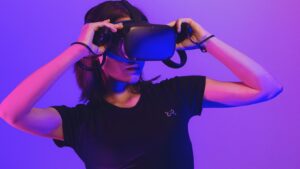Immerse yourself in the world of Virtual Reality (VR), a technology that’s not just reshaping entertainment, but revolutionizing sectors from healthcare to real estate. By simulating our senses, VR lets us experience a computer-generated world that’s incredibly close to—or wildly different from—reality.
This article will delve into the fascinating realm of VR, exploring its origins, evolution, and the groundbreaking ways it’s being applied today. Whether you’re a tech enthusiast, a curious novice, or a professional looking for the next big thing, we’ve got you covered. Stay with us as we journey into the virtual unknown, where the only limit is imagination.
The Evolution of Virtual Reality (VR)
Advancements in virtual reality trace back to the 1950s, a period marked by nascent ideas and crude prototypes. Morton Heilig, an influential visionary, kick-started VR’s journey with his prototype ‘Sensorama’. Heilig’s invention, however revolutionary, didn’t stir a significant interest in VR due to the technological limitations of that era.

VR’s real quantum leap arrived in the 21st century. 2010 marked a turning point when Palmer Luckey developed the prototype of Oculus Rift, the first truly immersive VR headset. Facebook’s acquisition of Oculus VR in 2014, for a staggering $2 billion, further underscored VR’s potential. It triggered an influx of investment, research, and development. Giants like Google, Microsoft, and Sony entered the fray, powering VR towards mainstream adoption.
How Virtual Reality (VR) Works
Delving into the workings of Virtual Reality (VR) provides insights into its transformative potential. Primarily, three essential components shape the VR experience: a computer, software, and a headset. The computer runs the virtual environment, facilitated by sophisticated software. Users wear the headset to immerse themselves in this digital landscape.
In more elaborate setups, additional paraphernalia such as VR gloves or bodysuits come into play. These devices translate physical movement into the virtual world, making users feel a part of the immersive virtual environment.

A typical VR system follows three main steps.
- Rendering: Computers generate a three-dimensional image, using mathematical formulas to create a realistic virtual world. High-powered computers ensure these images get rendered swiftly, maintaining a seamless VR experience.
- Display: The rendered image makes its way onto the screen housed inside the VR headset. Employing stereoscopic techniques, VR displays two slightly different angles of the image to each eye, creating a perception of depth and enhancing the immersive experience.
- Tracking: Sensors embedded in the headset track the user’s head movements. As users move or rotate their heads, the computer adjusts the images accordingly. Consequently, users perceive the virtual world as they would the real world, reinforcing the sensation of presence within the virtual environment.
Uses and Applications of Virtual Reality
Delving deeper into the world of VR, it’s clear the technology transcends gaming and entertainment, playing significant roles in a variety of sectors.
In healthcare, VR becomes an instrument for change, offering safe simulation environments for medical professionals in training. For instance, the Stanford Virtual Heart lets medical students navigate cardiac anatomy, enhancing understanding and honing surgical skills. Patients see benefits too. They undergo VR-guided therapy to help manage conditions such as PTSD, anxiety, and pain, with studies affirming these techniques’ efficacy.

Education and training find a trusted ally in VR as well. Google’s Expeditions project gives a glimpse of this, granting students access to immersive 360-degree environments, transforming textbook concepts into tangible experiences. Employees in high-stake industries like aviation and military get firsthand exposure to potentially dangerous scenarios without real-world risks, facilitating safer, more effective training methods.
In realms of architecture and construction, architects harness VR as a decision-making tool. Clients slip into headsets to navigate through digital mockups of their future residences or commercial buildings. As a result, architects garner constructive feedback instantly, enabling modifications prior to construction, thus saving time and minimizing waste.
VR reaches into the marketing field as well, enriching customers’ shopping experiences. Dutch beer brand Heineken, for example, takes customers on a VR-guided tour of their brewery, building brand stories in innovative ways. Retailers like IKEA and Lowe’s let customers visualize how products fit into their living spaces prior to purchase, creating a personalized, immersive shopping journey.
VR Technologies and Platforms
Advancements in Virtual Reality (VR) bring forth numerous technologies and platforms. Industry giants such as Oculus, Sony, and HTC provide ground-breaking tools and platforms that shape the industry. These players revamp human interaction with digital worlds, each offering unique features and experiences.
Oculus Rift
As a leading player in VR technology, Oculus Rift offers a powerful and immersive VR experience. Developers, using the Oculus SDK, get the chance to experiment with creating interactive 3D environments. This platform, paired with high-powered PCs, has broad applications. These range from gaming and entertainment to education and employment training.
Sony PlayStation VR

Sony’s PlayStation VR stands as a prime example of VR merging into mainstream gaming. The platform utilizes the popular PlayStation 4 gaming console, a compound of user-friendly accessibility and a large, gaming-enthusiast user base. It offers exclusive titles, pushing the boundaries of VR gaming.
HTC VIVE
The HTC VIVE prides itself on delivering room-scale VR experiences. It utilizes lightboxes that users install in their surroundings, tracking the user’s movements within a predefined space. This feature gives users the sensation of physically moving within the virtual environment, establishing a level of immersion unmatched by other platforms.
Google Cardboard

Google Cardboard democratizes VR, promoting accessibility. It’s a platform anyone with a smartphone can use, making it the most cost-effective solution. Despite its simplicity, Google Cardboard offers compelling VR experiences for users, with applications ranging from entertainment to education and real estate.
These platforms represent highlights in the VR sector, each contributing to the progression of VR technologies. They broaden VR horizons, leading the way towards a future filled with unimaginable, immersive experiences. As technology evolves, so does the potential of VR, paving the way for future developments in this exciting field.
The Future of Virtual Reality (VR)
Speculations abound on the future of Virtual Reality (VR). Reinventing user experience takes a front seat in these future projections. Advanced, task-specialized peripherals enhance immersion and interaction possibilities. These could range from gloves that simulate tactile feedback, haptic suits for full-body sensations, to VR treadmills for unrestricted movement. An example is TeslaSuit’s haptic feedback suit which takes VR experiences to another level by providing touch sensations and full-body motion capture.

Mass adoption of VR technology stamps itself as a significant factor for future progress. Improvements in affordability, portability, and user-friendliness of VR devices spark increase in global uptake. Facebook’s affordable, standalone VR headset, Oculus Quest, serves as an illustrative example, pushing boundaries of accessibility while preserving high-quality VR experiences.
With the uncharted territory ahead, constant advancements in AI and machine learning fabricate opportunities for VR development. Imagine AI-powered personal avatars becoming teachers, salespeople, and tour guides in virtual spaces, or complex machine learning algorithms creating customizable, immersive VR worlds catered to individual preferences. Such scenarios, once the domain of sci-fi, inch closer to reality with each passing year.

